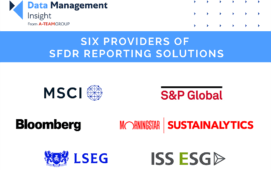
Snowflake’s Financial Services Data Cloud was launched in the middle of last year with the aim of providing financial institutions access to its cloud-native data resources. From the get go, the US-based company knew that ESG would be a major – and growing part – of its offering.
Now Rinesh Patel, Head of Industry, Financial Services, expects ESG disclosure to become the dominant factor in investors’ data requirements.
“As topics like climate change, biodiversity and business ethics are very much at the forefront of both public and political attention it’s also become the lens through which investors evaluate the companies that they want to invest in right now,” Patel tells ESG Insight.
“It’s becoming, as we see it, more important than the financial metrics that they’re historically used to using to evaluate corporate performance.”
Snowflake provides data warehousing and analytics for broad range of businesses. The platform acts like a meeting place for clients, data providers and analytics engines. The addition of the Financial Services Data Cloud brought asset managers, banks, insurers and funds together on a dedicated service for the first time.
It partners with data providers large and small, enabling clients to access cloud-managed services through one entry point. It has been busy building up its capabilities, recently acquiring Streamlit, an open-source data app creation and sharing platform.
“What we’re really trying to do is bridge together silos that exist in many organisations and collect those data assets together to allow an organisation to be able to seamlessly source data, aggregate data, apply the data and then share the data so that you can access insights very quickly and improve the data experience for customers,” he explains.
While the platform isn’t built solely for ESG data usage, Patel believes that it is this part of the business that will grow fastest in the coming years.
“ESG means a lot of different things to a lot of different people, therefore, we’re expect to continue to see a lot of different types and variety of data pertaining to those three letters start to make itself available,” he explains. “I see the challenge of ESG integration and ESG just becoming a lot bigger as we move through time.”
Five-Point Approach
Snowflake approaches ESG data as an enabler of five functions for financial services companies: It provides the information to score companies; screen them for portfolio inclusion or exclusion; provides the means to comply with emerging sustainability regulations; and gives marketing teams meat for strategies that stress companies’ ethical and sustainability postures. The fifth, and in some ways more unusual, is the use of data for quant investors.
Patel believes the programmatic firms will increasingly use ESG as a factor guiding their investment strategies.
“If you think about the quant research process as an organisation typically taking hundreds and hundreds of companies then applying factors like EBITDA, like margin revenue – now ESG becomes a factor that they’re adding,” he says.
“Those are the five areas that allow us to be laser focused on which data providers we bring on board, which service providers we bring on board.”
Data Agnostic
Snowflake has positioned itself as a solver of data problems for the financial services industry. It operates across cloud providers, can ingest any type of data and host a limitless number of vendors.
For ESG clients, one of the key problems it solves is time to market, Patel says, arguing that organisations are spending too much time managing data instead of using it. Gathering data from a variety of vendors and processing takes time, Patel argues. Simply identifying the right data for a company’s needs can be a grueling exercise.
In a process Patel likens to using Microsoft Teams, clients can access data providers that are already supported on Snowflake’s data cloud and use that without having to move the information from one place to another; or as he phrases it, “move the data challenges” around.
“Bringing all those data assets to market takes time and investors want the data quicker than ever before to be able to analyse ESG opportunity or risk,” he explains. “Our strategy is to bring together the right data sets, the right partners, the right capabilities to allow them to solve those sorts of industry problems.”
Vendor Integration
The data cloud was set up by working back from the key problems Snowflake saw its customers facing. Part of the solution has been to offer data in two ways.
It integrates access to providers such as Refinitiv, FactSet and S&P Global for clients that already use those services, and it also provides a Data Marketplace in which customers can choose providers they don’t already engage. While Snowflake doesn’t solve issues with data quality, Patel says it does improve the ability for organisations to use data in an intelligent way to solve use cases they have within ESG.
For instance, if a provider isn’t already feeding into the platform, Snowflake will seek to connect it. It will also guide clients to the right data for them, part of a “feedback loop” that Patel says helps clients target the exact data they need.
As a provider of computational processes it is crucial to Snowflake that it partners and connects with the the right data providers.
“ESG is very much a topical problem today, an industry problem that pretty much everyone from asset managers and banks and insurance firms are all trying to solve for,” Patel says.
“The financial service industry is very much a fragmented industry, where data kind of resides in many different places, is moved around physically from vendors to customers. What we’re really trying to do is democratise data and take away some of that pain of data management and improve the experience for our practitioners.”
Subscribe to our newsletter




